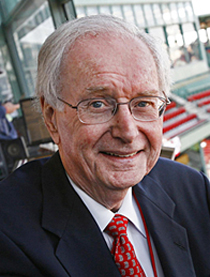
Culture
Gray's story is in part inspirational ... but it is also a story of missed opportunity ...

Flavin
"Good afternoon, baseball fans, and welcome to Opening Day of the 1945 season.
We're coming to you from Sportsman's Park in St. Louis, Missouri, where the defending American League champion St. Louis Browns are about to kick off the season against the Detroit Tigers.
"The pre-game ceremonies are over, the warm-ups have been completed, and as I glance across the field all seems in readiness for the first pitch and -- wait a minute! Jack, hand me those binoculars, will you? It looks like -- yes! I don't believe it! Fans, the left fielder for the Browns has only one arm!"
I don't suppose that the radio broadcast of that game actually started that way, but it might as well have. The left fielder for the Browns on Opening Day, April 17, 1945, just 75 years ago, was Pete Gray, who had lost his right arm in a childhood accident. He had a base hit and scored a run in his debut as the Browns defeated future Hall of Fame pitcher Hal Newhouser that day by a score of 7 to 1.
Gray's story is in part inspirational, that of perseverance and grit, of a young boy's determination not to let the handicap of a horrific childhood mishap hold him back from becoming a big league player; but it is also a story of missed opportunity, of someone who had the chance to be a role model for countless others, and who let that opportunity pass him by.
Gray, whose real name was Wyshner, was born in Nanticoke, Pennsylvania, in 1915. When he was only six, he fell off of a farmer's wagon and got his arm caught in the wagon wheel's spokes. The damage to it was such that it had to be amputated above the right elbow.
As he grew up, he developed baseball fever and, despite his handicap, was determined to play. He became an outfielder, first on the semi-pro level in and around Scranton, Pennsylvania, near the town of his birth. He eventually advanced to the minor leagues, where he continued to hone his skills. He became extremely adept at catching a ball with his left hand, quickly tucking his glove, from which he'd removed all the padding, under the stump of his right arm and, in the same motion, pulling the ball out of the glove's pocket and throwing it back to the infield. He did it all so fast that he'd get rid of the ball as quickly as a player with two arms and two hands. He had a strong throwing arm, the result, no doubt, of having to use it to do the work of two.
Pitchers in the minor leagues all assumed that Gray, a left-hand batter, would not, with the use of only one arm, be able to get around on fastballs. They were wrong. In 1944, playing for the Memphis Chicks in the Double-A Southern Association, he batted .333 in 129 games, hit five home runs (the only homers he ever hit in organized ball), stole 63 bases and, amazingly, led the league in fielding percentage. He was chosen as the league's Most Valuable Player.
The Browns took notice and, recognizing his potential as a gate attraction, bought his contract. He had finally made it all the way to the majors as a 30 year-old rookie who was missing an arm. Granted, it was 1945, America was still at war, and rosters were seriously depleted, but the fact that he made it at all was a baseball miracle.
It is said that in the minor leagues they find out what a player can do, but in the majors they find out what he can't do. So it was with Pete Gray; big league pitchers quickly discovered that curveballs, not fastballs, were his Achilles heel. With only one arm, he was unable to check his swing as a pitch broke outside the strike zone, so a steady diet of breaking balls is what he got. His batting average for 1945 was an anemic .218 and he had only 13 RBI in the entire year. Gate attraction or not, he was soon relegated to part-time status.
He was not at all popular with his teammates and made no attempt to become friendly with them. "Ornery" and "Hard to get along with" were words often used to describe him. The Browns were locked in a pennant race that year (they finished third) and many of Gray's teammates became convinced he was only with the team as a side show attraction and was otherwise a detriment to it. They resented him and, not liking him anyhow, made no secret of it. Many of them blamed Gray when the team fell out of contention. Clubhouse confrontations were not uncommon.
The next year, with all the stars returning from the war, there was no room on any big league roster for him, and he played out the rest of his career as a journeyman minor leaguer.
Despite all that, his story was an inspirational one, especially for wounded veterans returning from the war. But, although he did make a tour of hospitals with the USO, he never took full advantage of the opportunity he had been given to be a role model for others. He was uncooperative, shunned publicity, and never appeared at things such as old-timer games.
When his playing days were over, he returned to his home town of Nanticoke, where addictions to gambling and alcohol took control of his life and he lived in obscurity and near poverty. He never married.
In 1989, when Jim Abbott, who had been born without a right hand, made it to the major leagues as a pitcher for the California Angels, there was a resurgence of interest in Pete Gray. He'd mellowed out by then and expressed regret that he hadn't used his own story more to help others, but at age 74, it was too late. Abbott, by contrast, turned his disability into an asset and became a successful motivational speaker.
In 2002, Gray died at the age of 87 in the town where he was born. He accomplished the impossible in his lifetime, becoming a big league player despite the loss of an arm, but in the final analysis his is a sad story.
- Dick Flavin is a New York Times bestselling author; the Boston Red Sox "Poet Laureate" and The Pilot's recently minted Sports' columnist.
Recent articles in the Culture & Events section
-
'Dignitas' and the mediaRussell Shaw
-
Scripture Reflection for April 14, 2024, Third Sunday of EasterDeacon Greg Kandra
-
St. Helena's House is established in the South EndThomas Lester
-
Is this synodality?Russell Shaw
-
Poking the hornet's nest of IVFFather Tadeusz Pacholczyk


















